

Samantha Macchione
WELCOME! TED Talks- Can Technology Change Education. What do you want kids to do with technology? Integration of Technology in Learning. Technology Leads Education in the Future. Learning Outcome 1: Analyze the use of technology and examine its effects on cognitive, social and emotional well-being. How the Use of Technology Enhances Children's Development. Through the use of technology, children learn technology skills, while enhancing social and cognitive development.

Technology Skills As children use the computer and other forms of technology, they have the opportunity to meet the following technology standards. Established by the International Society for Technology in Education (ISTE), these standards are for children ages prekindergarten through second grade (2000). Use input devices (e.g., mouse, keyboard, remote control) and output devices (e.g., monitor, printer) to successfully operate computers, VCRs, audiotapes, and other technologies. David Elkind: Technology's Impact on Child Growth and Development. CIO — There is considerable disagreement among experts regarding the effects of technology on child growth and development.
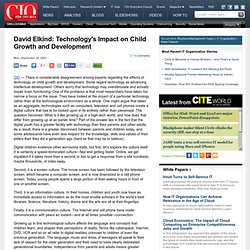
Some regard technology as advancing intellectual development. Others worry that technology may overstimulate and actually impair brain functioning. One of the problems is that most researchers have taken too narrow a focus on the issue. Teacher Education- Techn. Technology and interactive media. Rethinking Learning: The 21st Century Learner. Emotional Development.
The news media is filled with horror stories about young people and the Internet, but what is often overlooked and not reported are the benefits that technology, the Internet, and Social media have in building and enhancing social-emotional skills. Young people are doing what they have always done as part of their journey into adulthood, including socializing with peers, investigating the world, trying on identities and establishing independence, but now they are just doing so using the Internet and social media ( Seeing Social Media More as Portal Than as Pitfall ).
In 2011, the American Academy of Pediatrics Council on Communications and Media issued a clinical report, “ The Impact of Social Media on Children, Adolescents and Families .” It began by emphasizing the benefits of social media for children and adolescents, including enhanced communication skills and opportunities for social connections. ( Seeing Social Media More as Portal Than as Pitfall ) – Social Development. By Rick Nauert PhD Senior News Editor Reviewed by John M.
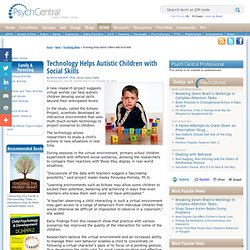
Grohol, Psy.D. on October 24, 2011 A new research project suggests virtual worlds can help autistic children develop social skills beyond their anticipated levels. Cognitive Development. Learning Outcome 2: Evaluate the use of technology as a reflective practice for children. Dewey Sequence Problem-Solving One of the most effective methods of problem solving is the Dewey Sequence.
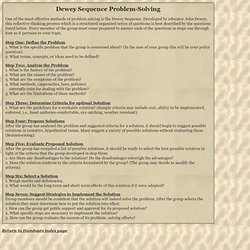
Developed by educator John Dewey, this reflective thinking process which is a structured organized series of questions is best described by the questions listed below. Reflective teaching: Exploring our own classroom practice. By collecting information about what goes on in our classroom, and by analysing and evaluating this information, we identify and explore our own practices and underlying beliefs. This may then lead to changes and improvements in our teaching. Reflective teaching is therefore a means of professional development which begins in our classroom. Why it is importantBeginning the process of reflection Teacher diary Peer observation Recording lessons Student feedback What to do next Think Talk Read Ask Conclusion Why it is important Many teachers already think about their teaching and talk to colleagues about it too.
You might think or tell someone that "My lesson went well" or "My students didn't seem to understand" or "My students were so badly behaved today. " A voice for Social Good. I was teaching a Psychology of Adjustment course to undergraduates.
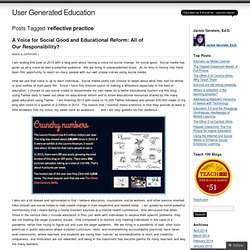
Most of them were 18 and 19 years old. It was a college in Georgia with a class demographic of about 2/3 who were White and 1/3 Black. We got to the section on cultural diversity awareness. Because it was the South, we began our discussion about racial differences. At one point during the discussion, an attractive, blond, former high school quarterback said, “America is a free country. Fast forward one class session, I did the “White Privilege” activity with the students. I told this story to a colleague. Given the way the US politicians communicate regarding the country’s issues, they could have benefited from learning how to communicate, listen, debate, and compromise over diverse issues and ideas. Topics covered in this post include: A Rationale for Learner Voice in School To do so, school personnel need to be intentional in promoting and living the ideals of democracy.
The Role of the Educator. Flipping Online- Maintaining the In-Class Feel. A different approach to child portfolios. More Progressive Ways to Measure Deeper Level of Learning. Big Ideas Erin Scott How do we measure learning beyond knowledge of content?
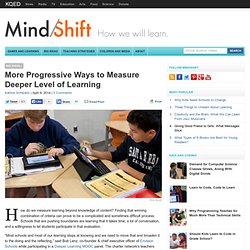
Finding that winning combination of criteria can prove to be a complicated and sometimes difficult process. Schools that are pushing boundaries are learning that it takes time, a lot of conversation, and a willingness to let students participate in that evaluation. “Most schools and most of our learning stops at knowing and we need to move that and broaden it to the doing and the reflecting,” said Bob Lenz, co-founder & chief executive officer of Envision Schools while participating in a Deeper Learning MOOC panel. “The real power comes in the reflective process, both individually and with peers,” Lenz said. Teaching rubrics are a common tool in any classroom, but they can easily become a disguised checklist of tasks, instead of a living document designed to structure learning towards a desired skill or outcome. “Assessment is really time consuming and exhausting,” Staff said. Related. Social Networking Sites. Learning Outcome 3: Develop strategies on how to integrate technology with the curriculum.
Howard Gardner's Multiple Intelligences. Getting children to appreciate what technology has to offer. Grammar Help with Technology. A Reflection: Getting Started With Google Drawing. Show Me The Potential I had not used Google Drawing at all with students prior to the Alberta GAFE Summit and dismissed it as something similar to Microsoft Paint but online.
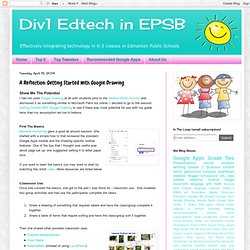
I decided to go to the session Getting Started With Google Drawing to see if there was more potential for use with my grade twos than my assumption led me to believe. First The Basics Michelle Armstrong gave a good all around session. She started with a simple how to that reviewed the standard Google Apps toolbar and the Drawing specific toolbar features. Using Apps and E-Books in Early Literacy Programs. Here are our slides from ECRR 2.0: Using Apps and E-Books in Early Literacy Programs.
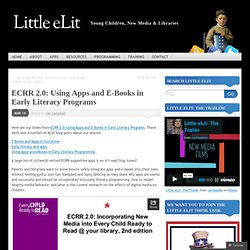
There were also a number of ALSC blog posts about our session: E-Books and Apps in StorytimeEarly literacy and appsUsing Apps and eBooks in Early Literacy Programming. Children's interactions with iPad books: research chapters still to be written. Children's interactive e-books are novel literacy tools with interactive and multimodal representations of story contents and increased customizable features.
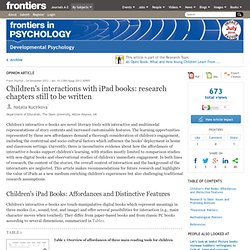
The learning opportunities represented by these new affordances demand a thorough consideration of children's engagement, including the contextual and socio-cultural factors which influence the books' deployment in home and classroom settings. Currently, there is inconclusive evidence about how the affordances of interactive e-books support children's learning, with studies mostly limited to comparison studies with non-digital books and observational studies of children's immediate engagement. Teacher Education- Tech. Are E-Books Better or Worse Than Print For Kids? Both. Are E-Books Better or Worse Than Print For Kids?

Both Those fancy interactive e-books on tablets may not be the improvement over print that they appear to be: Research indicates reading comprehension is higher in kids reading plain old paper books — but that doesn't mean e-books don't have a place in education. The New York Times reports on ongoing research by Jordan Schugar and Heather Ruetschlin Schugar of West Chester University of Pennsylvania; the couple have been comparing the reading habits of grade-schoolers in e-books and print for some time. Their latest findings were presented at the annual meeting of the American Educational Research Association. Teachers learn to integrate technology into curriculum. Apps for iPads in the Classroom. Best Science Apps For Kids. Learning Outcome 4: Discuss different strategies on incorporating technology in the classroom.
When technology integration in the classroom is seamless and thoughtful, students not only become more engaged, they begin to take more control over their own learning, too. Effective tech integration changes classroom dynamics, encouraging student-centered project-based learning. Think about how you are using technology with your students. Are they employing technology daily in the classroom, using a variety of tools to complete assignments and create projects that show a deep understanding of content? If your answer is "No," is it because you lack enough access to technology? Is it because you don't feel ready? 21st Century Education. How teachers and students are adjusting to the digital classroom. An occasional series on how digital culture affects the way we think, learn and live The kindergarten student, a shy, Mandarin-speaking five-year-old immigrant in the tiny community of Sangudo, Alta., had barely spoken a word during the first three months of class.
So her teacher was surprised one day last year when the girl struck up a conversation. The subject of their animated discussion? Digital Citizenship. New Tactics For Teachers. Resources For Teachers. The Use of Cell Phones in Class. "I Can" Statements. More useful apps! An approach to homework with assistive technology. Student Moodle Homework Assignment What is the Moodle Homework Assignment? The student Moodle Homework Assignment was created to help students become familiar with Moodle, and with your course site.
The Homework Assignment attempts to cover many of the aspects of Moodle that are commonly used in courses, and which students may encounter difficulties with if they are new to Moodle. It is our hope that students will resolve any potential issues or questions as they work through the Moodle Homework Assignment, making for a smoother semester for you! Why should I use the Moodle Homework Assignment? Asking students to complete the Moodle Homework Assignment at the beginning of the semester can help you, the instructor, to solve any technical glitches early on. How do I start? We recommend that you start by building your Moodle course with the resources and activities that will be beneficial to you and your students. 10-Step Process for Instructors Click on the tabs below to explore the 10 steps.
Angry Birds Rio Online - Play Angry Birds Games for Free at AngryBirdsGames.com! Educational Benefits of Video Games. Learning Outcome 5: Discover technology programs to formulate children’s drive for creativity. Teachable Moments For Digital Citizenship. Study's the name of the game - Sydney Morning H. Love, the app for iPad - Digital Storytime. Technology, Instruction and the 21st Century Classroom. Classrooms in the 21st century are undergoing a rapid transformation into new learning environments that are highly flexible, configurable and collaborative. Creativity for children with the use of apps. Learning Outcome 6: Critique the effectiveness of social media as a means to create constructivism in the classroom. How social media helps bridge the gap between home and school. New York City Education - Social Media Guidelin. Apps for Healthy Kids. This Is How Teens Are Using Social Media.
Form of Documentation. Using Twitter for Learning. Education Week. Final Thoughts. The White House Student Film Festival: Technology in Classrooms. Assessment. References.